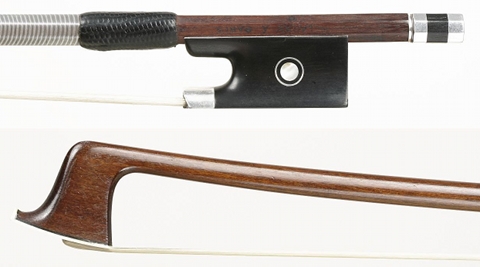ANDRE' GEORGES RICHAUME; THE NEPHEWIt is the fate occuring to talented craftsmen, who, often more than other one much more famous than them, just enjoy making bows . More interested to construction than trade, they work all his life for someone else, maybe a famous relative, thus increasing the fame of the latter and putting themselves aside in a secondary role. Do you remember who Andrè's famous relatives were ? Violin bow André Georges Richaume in silver and ebony The surname of André Georges' father , Louis Justin Richaume, does not actually recall famous bowmakers. But if you look at his mother's surname everything becomes clearer. André was born in Mirecourt on February 8, 1905, son of Marie-Augustine Fétique. Indeed she was the sister of two of the most famous bowmakers of France in the second half of the nineteenth century: i.e. Jules and Victor Francois Fétique. The young Richaume carries out his apprenticeship in Mirecourt, and although not confirmed, looking at some bows of that time it is reasonable to think that he, as his eldest brother, Raymond Jules Louis, was trained in Emile Francois Ouchard's workshop. Having reached a high technical level, after his military service in 1927, he moved to Paris to study with his uncle Victor, with whom he remained until his death in 1933. In these years he has the opportunity to attend many excellent craftsmen who worked in the city. He is affected, as everybody else by the charm of the "Raptor" Sartory, whose work he knows , and with whom he gets in touch through the other uncle, Jules, since, as you know, he worked for him until 1929. In 1932 he marries Marie Marcelle Zoé Grelot, and the same year he opens his own laboratory at 60, Boulevard de Clichy. He is a son of the school Sartory / Fetique (Jules), not only in style, but also in the selection criteria of the material. The pernambuco that André uses is of excellent quality, and in his works as well, like in those of his masters, one can watch colors of wood ranging from golden yellow to dark red . Fastidious and painstaking in his work, his bows besides from working from a mechanical point of view, are also aesthetically cared, he rejects the invitation of the house Chardon to attend the Great Exhibition in Paris in 1937, not having the necessary time to prepare something up to his level. In 1955 he was awarded the prize as "Un des Meilleurs Ouvrier de France", (One of the best craftsmen in France). In 1958, as evidenced in an article by Michel Winthrop (L'Archet - Millant / Raffin), he receives the visit of a violinist to whom every luthier or bowmaker would be proud to show his work, none other than David Oistrakh. Igor's son had purchased a Richaume in Buenos Aires the past year and considering that David liked it very much, he gave it to him. In 1958, in fact Oistrakh, who was in Paris for concerts, wanted to know the author of the bow that would have accompanied him until the end of his career. He got sick and dies on March 31, 1966, at the age of 61 years. He leaves behind him many good bows, appreciated by collectors, musicians, rightly gaining a place among the best makers of the twentieth century. The bows
Violin bow André Georges Richaume As every good craftsman, Richaume also manages to convey his character to the work he does. The bows are carried out in a perfect way and work perfectly, but sometimes they are a little too stiff ("As the one who built them," says one person who knew him ). Andrè's stylistic periods are mainly two , the first one refers to his teacher in Mirecourt, Emile Francois Ouchard. After moving to Paris, his taste will be gradually directed toward the rulers of the time, Jules Fetique and Sartory. The heads become softer and rounded. From his notes there is evidence that he built : 1000 bows in ebony and silver , 15 in ebony and gold, 13 in gold and ivory, 60 in gold and tortoise , 50 in ivory and silver, 20 in horn and silver. Andrè Georges Richaume worked for : Albert Caressa, Emile Francais, Victor Fetique, Emile Francois Ouchard Stamp : A. RICHAUME à PARIS References: JULES FETIQUE; THE OTHER SARTORY VICTOR FRANCOIS FETIQUE; THE WEAK THE OUCHARDS AND THE GRAIL QUEST EUGENE NICOLAS SARTORY; THE VELOCIRAPTOR So long Paolo
|
   |






